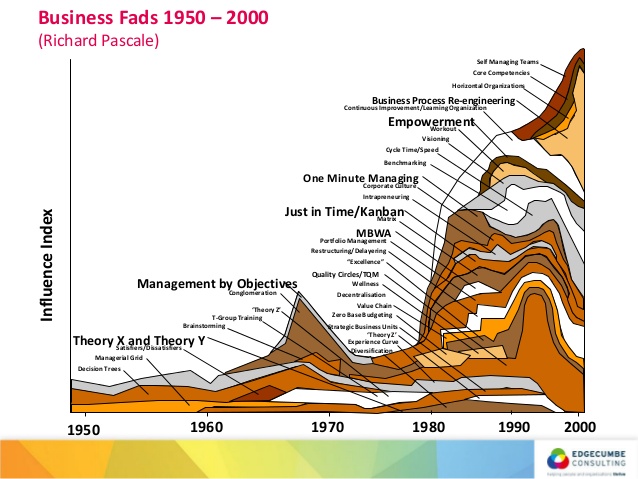People don’t resist change, they resist bullshit – Peter Vander Auwera
A friend of mine told me last week that their organisation was about to begin its third change management programme in just seven years.
Each of the two preceding programmes had a number of things in common:
- People were unclear why a programme was needed in the first place.
- They had – seemingly – never been evaluated. Neither demonstrated what had been achieved or learned.
- They had all been accompanied by processes, tools and practices that had long since been abandoned.
“The only thing that really stuck,” he said ” were the buzzwords”.
In his book Business Bullshit, Andre Spicer looks at how organisations have become vast machines for manufacturing, distributing and consuming bullshit. He takes us back to the birth of the management change movement – the 1960s and 1970s – when big consultancy began to see a vast new market – convincing organisations of the benefits of ‘transformation’ and ‘being their best self’.
Alongside this came the development of a distinctive, pseudo-scientific language of change which was needed to pitch themselves to clients.
Quite coincidentally the book I read before this was Selfie by Will Storr, about our culture of personal narcissism and self-obsession.
Events in both books intersect at the Esalen Institute, in California, where people get in touch with their hidden selves through group therapy and sensitivity training. Esalen gave birth to the dubious Human Potential Movement (simply believe in yourself more and you too can be Beyonce, fail and you simply didn’t want it enough.)
I’d never before made this connection between the personal self-improvement movement and the world of corporate change.
Both philosophies propose that there’s always a better version of you out there in the future. And by following a series of best practices, toolkits and templates that version of you can be realised.
Arguably, our obsession with business change is as much a symptom of modern narcissism as is the fact we take 1 million selfies each day.
Your change vision, like that perfectly framed Instagram pose, is bullshit – and everybody knows it.
Do You Really Need Another Change Programme?
Change is not about going from one point to another, reaching a mythical ‘to be’ state and stopping there. The most important thing is what takes place from point A to whatever happens next – and that will almost never be what you predicted or what it says on a Gantt chart. Nobody can possibly know what will happen when you change things.
That’s why large-scale transformations become too big to fail – resulting in a ‘wall of silence’ when objectives don’t get met.
Spicer maintains that today bureaucracy comes cloaked in the language of change with our organisations full of people whose job is to create change for no real reason.
Change, both personal and corporate, simply isn’t always needed.
Knowing the problems you need to fix and the ones you don’t is a key advantage.
Crucially, the evidence base for change is often suspect. In his book Will Storr argues that the origins of the whole self-improvement industry were founded on very shaky evidence from the start – with scientists’ less than enthusiastic findings being airbrushed from a final report.
Far from pursuing some unrealistic dream, perhaps we’d be much happier if we learned to live with our imperfections, neuroses and human frailties.
How To Avoid Corporate Narcissism
Maybe we need to accept that not all problems are there to be fixed. That our organisations are flawed. They always have been and always will be.
Perhaps we need:
- Reflection and contemplation rather than lots of management activity.
- Devolving resources and influence to those closest to the problem.
- Changing little and fast through small-scale experimentation.
- Not rolling out anything until we have evidence that it works.
And that’s led me to consider the failure rate of change programmes and the impossibly high goals that organisations set.
The weight loss industry is booming – and so is obesity.
The change industry is booming – and productivity is tanking.
- Maybe your organisation is unique because of its flaws.
- Maybe you don’t need to follow a consultant led template of what great looks like.
Being a human organisation means resisting someone else’s idea of perfection.
It means recognising you’ll always be flawed – and there’s a beauty in that.
I’m never going to be Elon Musk. Your organisation is never going to be Apple.
Maybe you’re meant to be that way.

Leave a comment